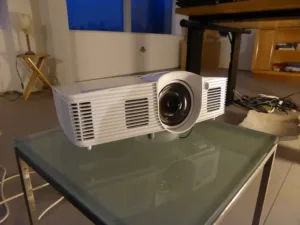I was able to test Optoma’s GT1080 gaming projector recently, which we saw at last year’s Technology Exposed show (Technology Exposed Roundup). Being a gamer, it sounded like a good opportunity to put the product through its paces!
The first challenge came in the set-up: it’s been a long time since I arranged a projector for viewing. However, Optoma had me covered. The GT1080 really is ‘pick up and play’, and only required the correct positioning and sources. There was no fussing with keystone correction or wall colour adjustments – it was just ready to go. Much appreciated for gamers, although it should be noted that functions like zoom and lens shift are not built in. Image alignment is solely through physically moving the projector and digital keystone adjustments.
Something else to note is that the GT1080 only has HDMI (x2) ports as its inputs: there is no analogue interface. This is not a huge surprise, as VGA is usually built in to projectors these days to support use in business environments, which use legacy laptops. HDMI is well established on modern consoles, PCs and gaming laptops. The product also has a 12V trigger port, to control a motorised screen, and a port to add a 3D transmitter (although this is not included in the box).
As a DLP projector, the GT1080 features TI’s BrilliantColor technology; that’s marketing-speak for a six-segment colour wheel. Levels are adjustable: the unit was set to BrilliantColor 9 originally (out of 10). Of course, this is not the most accurate setting but does saturate the colours, making them appear very bright and vibrant. The feature can introduce noise to an image, though – I found that a setting of two or three was optimal.
That’s not right…I’m between houses at the moment, and so my next challenge came in two forms: finding an area of wall large enough to act as a screen, and finding content to play on it. The projector has a short-throw lens, and so when I first turned it on, at about 2m from the wall, the image was around 3.6m along the horizontal edges! I eventually settled on a 0.7m throw distance, which output a 55″ image. The lens did introduce some uniformity errors, primarily a lack of focus at the edges of the image, but this was easy to fix using the manual focus adjustment.
Next, the content issue. I have a PlayStation, but all of my games are packed up in boxes. Luckily, I had downloaded free running simulator Mirror’s Edge to the hard drive. This is not the most demanding game (it was released in 2008), but as I was mainly testing frame rate was a good stand-in, with its twitchy controls and need for very precise timing.
Mirror’s Edge is a very colourful game, set in a city of glossy windows and bright skies. The first thing that I had to do on boot-up was lower the projector’s brightness and change some colour settings to achieve an optimal picture quality. Optoma is known for the extensive picture calibration features built into all of its projectors, and so this was no trouble. All six colours on the colour wheel can be managed, as well as settings like contrast, sharpness and colour temperature. Pre-calibrated settings are available for several types of content, such as game, film, video and graphics.
I was gaming, so of course mostly used the gaming preset, which favours low response times, high contrast and a sharp picture. Vibrant mode is very similar, though with more attention paid to colours. The downside of both is that some detail is lost in the very bright areas – and, as mentioned, Mirror’s Edge is a colourful game. Reds (a focal colour of the title) looked particularly over-saturated, although this appeared to be down to a combination of the projector and game. It was much less of an issue when opening another game, and not at all when using the film mode to watch video from Netflix.
While playing, I was pleased with the 15ms response time of the projector: any deaths were (embarassingly) my fault, rather than the display’s. Colours were strong, as mentioned, and contrasts pronounced. Black levels were less dark than I’d have liked, but this is, after all, a (relatively) budget projector – don’t expect to get an HDR experience here. As long as the brightness wasn’t set to full, this wasn’t an issue.
The only other issue that I had with the projector was in its sound quality. The 10W speaker can output passable audio, but is limited to mono rather than stereo. It is very light on bass and can sound tinny. I would recommend an external speaker, rather than relying on the projector to fulfil home audio needs.
Overall, I can recommend the GT1080 to gamers who have the wall (and floor) space and budget. More time than I was able to give it may sort out those colour issues, but if not, turning down BrilliantColor is a stop-gap measure. (TA)

